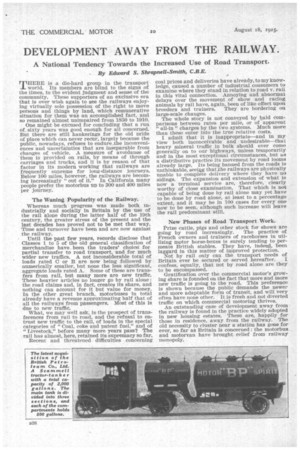DEVELOPMENT AWAY FROM THE RAILWAY.
Page 10

If you've noticed an error in this article please click here to report it so we can fix it.
A National Tendency Towards the Increased Use of Road Transport. By Edward S. Shrapnell-Smith,
?THERE is a die-hard group in the transport 1 world. Its members are blind to the signs of the times, to the evident judgment and sense of the community. These supporters of an exclusive era that is over wish again to see the railways enjoying virtually sole possession of the right to move persons and things by land, which remunerative situation for them was an accomplished fact, and so remained almost unimpaired from 1850 to 1910.
One might be excused for concluding that a run of. sixty years was good enough for all concerned. But there are still hankerings for the old pride of place which can never recur, largely because the public, nowadays, refuses to endure the inconveniences and uncertainties that are inseparable from changes of vehicle. A measure of avoidance of -them is provided on rails, by means of through carriages and trucks, and it is by reason of that factor in its modern working that railways are frequently supreme for long-distance journeys. Below 100 miles, however, the railways are becoming increasingly "out of it." In California many people prefer the motorbus up to 300 and 400 miles per journey.
The Waning Popularity of the Railway.
Whereas much progress was made both. industrially and socially in Britain by the use of the rail alone during the latter half of the 19th century, the greater stress of the present and the last decades has proved not to be met that way. Time and turnover have been and are now against the railway.
Until the past few years, records disclose that Classes 1 to 5 of the old general classification of merchandise have been the traders' choice for partial transfer to road transport, and for much wider new traffics. A not inconsiderable total of loads rated C or B are now being followed by numerically smaller, but none the less significant, aggregate loads rated A. Some of these are transfers from rail, but many more are new traffic. These heavier articles no longer go by rail alone : the road claims and, in fact, creates its share, and nothing can account for it but value for money. In the other great branch, motorbuses in total already have a revenue approximating half that of all the railways from passengers. Most of this Is due to new traffic.
What, we may well ask, is the prospect of transferences from rail to road, and the refusal to entrust new traffic to the rail, of loads in the special categories of "Coal, coke and patent fuel," and of "Livestock,", before many more years pass? The rail has almost, here, retained its supremacy so far. Recent and threatened difficulties concerning coal prices and deliveries have already, to my knowledge, caused a number of industrial consumers to examine where they stand in relation to road v. rail in this vital connection. Annoying and abnormal delays over the movement of show and racing animals by rail have, again, been of like effect upon breeders and trainers. They are bordering on large-scale changes.
The whole story is not conveyed by bald comparisons between rates per mile, or of apparent " all-in " charges by the two systems. Much more than these enter into the true relative costs.
I admit that it is inappropriate—and in my view both inconceivable and undesirable—that heavy mineral traffic in bulk should ever come generally on to our highways, unless temporarily andin the most exceptional circumstances, but as a distributive practice its movement by road looms already large. Its being banned from the roads i9 unthinkable, seeing that he railways are physically unable to complete delivery where they have no sidings. The expansion and extension of what is now a terminal service are, therefore, clearly worthy of close examination. That which is no capable of being done by rail alone may yet have to be done by road alone, at least to a percentage extent, and it may be in 100 cases for every one now to be seen, although such increase will leave the rail predominant still.
New Phases of Road Transport Work.
Prize cattle, pigs and other stock for shows are going by road increasingly. The practice of French owners and trainers of racehorses in utilizing motor horse-boxes is surely tending to permeate British stables. They have, indeed, been laggard in this matter of improved protection. Not by rail only can the transport needs of Britain ever be secured or served hereafter. I confess, equally, that not by road alone are they to be encompassed.
Gratification over the commercial motor's growing share is founded on the fact that more and more . new traffic is going to the road. This preference is shown because the public demands the newer and more adaptable form of transit, and will very often have none other. It is fresh and not diverted traffic on which commercial motoring thrives. An outstanding case of development away from the railway is found in the practice widely adopted in new housing estates. These are, happily for those in residence, away from the railway. The old necessity to cluster near a statiOn has gone for ever, so far as Britain is concerned : the motorbus and motorvan have brought relief from railway monopoly.




























